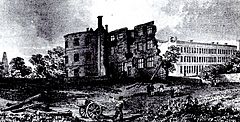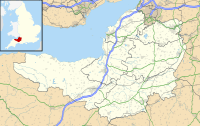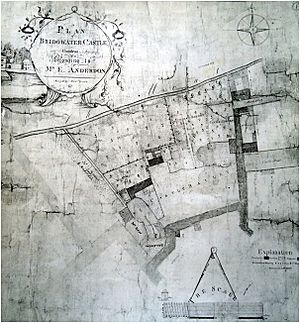Bridgwater Castle facts for kids
Quick facts for kids Bridgwater Castle |
|
|---|---|
| Bridgwater, Somerset | |

Remains of the mansion on the site of the castle keep, with houses to the right on Castle Street. Lithograph after a painting in the mid 18th century by John Chubb
|
|
| Coordinates | 51°08′07″N 2°59′56″W / 51.1352°N 2.9990°W |
| Type | Castle |
| Site history | |
| Built | 1202 |
| Built by | William Brewer |
| In use | 1202-1645 |
| Materials | Old Red Sandstone |
| Demolished | 1645 |
Bridgwater Castle was a historic castle located in the town of Bridgwater, Somerset, England. It was built from stone around 1220. The castle played a big part in helping the town of Bridgwater grow and become important.
It had a moat (a deep, wide ditch filled with water) all around it. There was also a special watergate that allowed boats to access the nearby quay (a landing place for ships). Over the years, the castle was involved in some important historical events, like the Second Barons' War and the Despenser War.
Later, the castle started to fall apart. Parts of it were pulled down in the early 1600s, and a new house was built on the site. Even so, some of the old walls remained. These surviving parts were used during the English Civil War and the Monmouth Rebellion. By the 1700s, most of the remaining castle buildings were gone. New homes and businesses were built, and a street called Castle Street got its name from the old castle site. Today, you can still see the watergate and some sections of the original castle wall.
Contents
Building Bridgwater Castle
The castle was built in the early 1200s by a very rich man named William Brewer. He was given control of the area around Bridgwater by King John in 1201. Before the castle was built, Bridgwater was a much smaller place.
King John gave permission to build the castle in 1200. After that, the town quickly grew. Charters were given to create a borough (a town with special rights) and a market. This helped make Bridgwater the heart of a new, busy town.
Castle Construction and Features
Bridgwater Castle was a large structure. It was built using Old Red Sandstone from a nearby area called Wembdon. Other stones were brought by boat from places like the Polden Hills and Ham Hill. The castle grounds covered about 8 or 9 acres (32,000 to 36,000 square meters).
The castle had a wide tidal moat, which was up to 65 feet (20 meters) wide in some places. This moat was filled with water from a stream called Durleigh brook. The main entrance to the castle was unusual. It had two gates and two drawbridges side-by-side.
Inside the castle complex, there was a keep (the strongest tower), a dungeon, a chapel, stables, and a bell tower. The castle was built on the only high ground in the town. This allowed it to control the important town bridge crossing.
What Remains Today?
Historical records show the castle had an outer and inner bailey (courtyards). It also had a constable's house, a chapel (St Marks), a great hall, stables, kitchens, and a gatehouse. There was even a dovecote (a building for doves or pigeons).
Today, you can still see a 12-foot (3.7-meter) thick part of the castle wall and the water gate on West Quay. These are protected as important historic buildings. Remains of another wall, likely from inside the castle, can be seen in Queen Street and the garden of Lions House.
Castle Ownership Changes
William Brewer, the builder, died in 1226. His son, also William, died in 1232. After this, the castle went to the king and was used as a storage place and a prison. In 1248, the castle was given to Maud de Braose, Baroness Mortimer. Her husband, Roger Mortimer, 1st Baron Mortimer, was involved in the Second Barons' War.
During the Despenser War in 1321, King Edward II took control of Bridgwater Castle. He wanted to stop Roger Mortimer, 1st Earl of March from using it as a base. After Mortimer returned from France and took the throne, the castle was given back to his family.
However, the castle was not well looked after. Parts of the moat were filled in. Only the chapel and a barn were repaired for a long time. By the 1450s, private houses were being built inside the castle walls. The castle's military importance was decreasing. By the 1540s, it was described as "all going to mere ruin." A house was built on the site after part of the castle collapsed in 1548.
Castle in Conflict
In the early 1630s, the owner, Henry Harvey, pulled down some of the castle's outer walls. He used the stone to build his new house. Harvey had bought the castle site from George Whitmore, who had received it from King Charles I in 1626.
English Civil War Role
In 1642, the English Civil War began between King Charles I and Parliament. Bridgwater town and its castle were still seen as important. A group of soldiers loyal to the King (called Royalists) were stationed there under Edmund Wyndham.
During the fighting, Wyndham's wife, Lady Crystabella Wyndham, famously fired a musket from the castle wall. She aimed at Oliver Cromwell, a leader of the Parliamentarian forces, but missed him. The castle and its valuable contents were eventually given up to the Parliamentarians on July 21, 1645.
After the war, in 1651, Colonel Wyndham helped King Charles II escape to France after the Battle of Worcester.
Castle's Destruction
Some historians believe the castle was deliberately destroyed in 1646 by order of Parliament. This was done to prevent it from being used again in future conflicts. However, more recent studies suggest that much of the castle was already ruined by then. It was likely only the remaining walls and new defenses that were pulled down.
Although Robert Blake, a famous English admiral, was born in Bridgwater, he is not thought to have fought in the town itself. He was involved in other important sieges nearby.
Monmouth Rebellion
The castle site also played a small role in the Monmouth Rebellion of 1685. Rebel troops were trapped in Bridgwater on July 3. They were ordered to strengthen the town's defenses before the Battle of Sedgemoor.
Rebuilding the Site
In the late 1600s, John Harvey continued to develop the castle site. In 1721, the remains of the castle, the house, and the land were sold to James Brydges, 1st Duke of Chandos. He wanted to create an industrial center in the town. He had the last of the old castle buildings demolished.
Much of the site was rebuilt in the 1720s to create the beautiful Georgian Castle Street. In 1734, Chandos sold the entire redevelopment area. The new owners continued to clear old buildings and construct new ones.
King Square was built between 1807 and 1814. Many of the buildings there used stone from the old castle. It's possible that some of their cellars and foundations are actually parts of the original castle walls. In 2008, during sewer work, a section of the castle's outer wall and a tunnel were found. This tunnel was likely used to move goods from the port.
Today, parts of the castle wall, the water gate, and an undercroft (an underground room) still survive.





